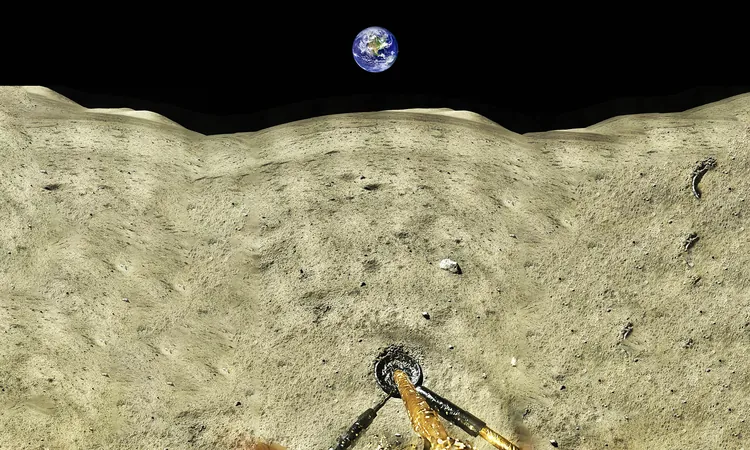
Unveiling the Secrets of the Moon: Volcanic Activity on the Far Side for Over a Billion Years
2024-11-19
Author: Charlotte
Have you ever gazed up at the night sky and marveled at the Moon's serene presence? While most of us are familiar with the Moon's near side, the hidden far side, which never faces Earth, has long been shrouded in mystery. Thankfully, groundbreaking research led by Professor XU Yigang from the Guangzhou Institute of Geochemistry at the Chinese Academy of Sciences is starting to illuminate some of these lunar enigmas.
A Journey to the Far Side
The crux of this research hinges on lunar soil samples collected during China’s ambitious Chang’e-6 mission. Launched on May 3, 2024, this spacecraft was designed with the goal of retrieving approximately four pounds (2 kg) of lunar rock from the Moon's far side, an unprecedented feat in space exploration history.
The Chang’e-6 mission successfully landed in the South Pole-Aitken Basin, one of the Moon's largest and oldest craters. The mission utilized advanced technology to collect samples, drilling two meters into the lunar surface and conducting in-situ analysis with a small rover that documented its exploration.
On June 25, 2024, the spacecraft made a successful return to Earth, landing in Inner Mongolia and bringing back about 4.2 pounds (1.9 kg) of precious lunar materials. This marked a significant achievement for China’s growing space program and set the stage for new scientific discoveries.
A Closer Look at Lunar Dynamics
When comparing the Moon's near side to the far side, there are striking differences in topography and composition. The near side is famous for its vast dark plains known as "maria," which were formed by ancient volcanic activity. In contrast, the far side is less dominated by these basalts; in fact, only about 2% of this region is covered with basalt, compared to about 30% on the near side. This stark contrast has puzzled scientists and highlights the need for further exploration of the Moon's history.
Revelations from the Chang’e-6 Samples
The analysis of the samples from Chang’e-6 revealed two distinct types of mare basalts: low-titanium (Ti) and very low-titanium (VLT). What’s even more astonishing is that through advanced Pb-Pb dating techniques, researchers discovered that the low-Ti basalts trace back to around 2.83 billion years ago, indicating that volcanic activity continued on the far side of the Moon well into the late lunar history.
A particular fragment, distinguished as a high-aluminum basalt, was dated to an incredible 4.2 billion years, marking it as the oldest lunar basalt with a precisely determined age. This suggests that volcanic activity on the far side persisted for at least 1.4 billion years, bridging a critical gap in our understanding of lunar geology.
The Significance of This Research
These findings have far-reaching implications. They not only recalibrate models of lunar crater chronology but also offer insights into the historical impact fluxes that have shaped our own Solar System, painting a broader picture of planetary evolution.
Professor Christopher Hamilton noted the importance of these discoveries, emphasizing how they are crucial to refining our understanding of planetary growth and migration, which could ultimately enhance our knowledge of Earth’s formation as well.
Looking Ahead
As we venture further into lunar exploration, missions like Chang’e-6 promise to unveil more secrets of our celestial neighbor. The Moon, despite its familiar visage, holds many mysteries waiting to be unraveled, beckoning both astronomers and enthusiasts alike.
Each lunar mission propels us into a new age of exploration, where every sample collected and every find made contributes to a deeper understanding of not just the Moon, but of our place in the cosmos. The excitement surrounding these discoveries suggests that much more is yet to come — and who knows what extraordinary revelations await us just beyond the Moon's horizon!
Stay tuned, as the next chapter of lunar exploration may soon write itself in the stars.









 Brasil (PT)
Brasil (PT)
 Canada (EN)
Canada (EN)
 Chile (ES)
Chile (ES)
 España (ES)
España (ES)
 France (FR)
France (FR)
 Hong Kong (EN)
Hong Kong (EN)
 Italia (IT)
Italia (IT)
 日本 (JA)
日本 (JA)
 Magyarország (HU)
Magyarország (HU)
 Norge (NO)
Norge (NO)
 Polska (PL)
Polska (PL)
 Schweiz (DE)
Schweiz (DE)
 Singapore (EN)
Singapore (EN)
 Sverige (SV)
Sverige (SV)
 Suomi (FI)
Suomi (FI)
 Türkiye (TR)
Türkiye (TR)